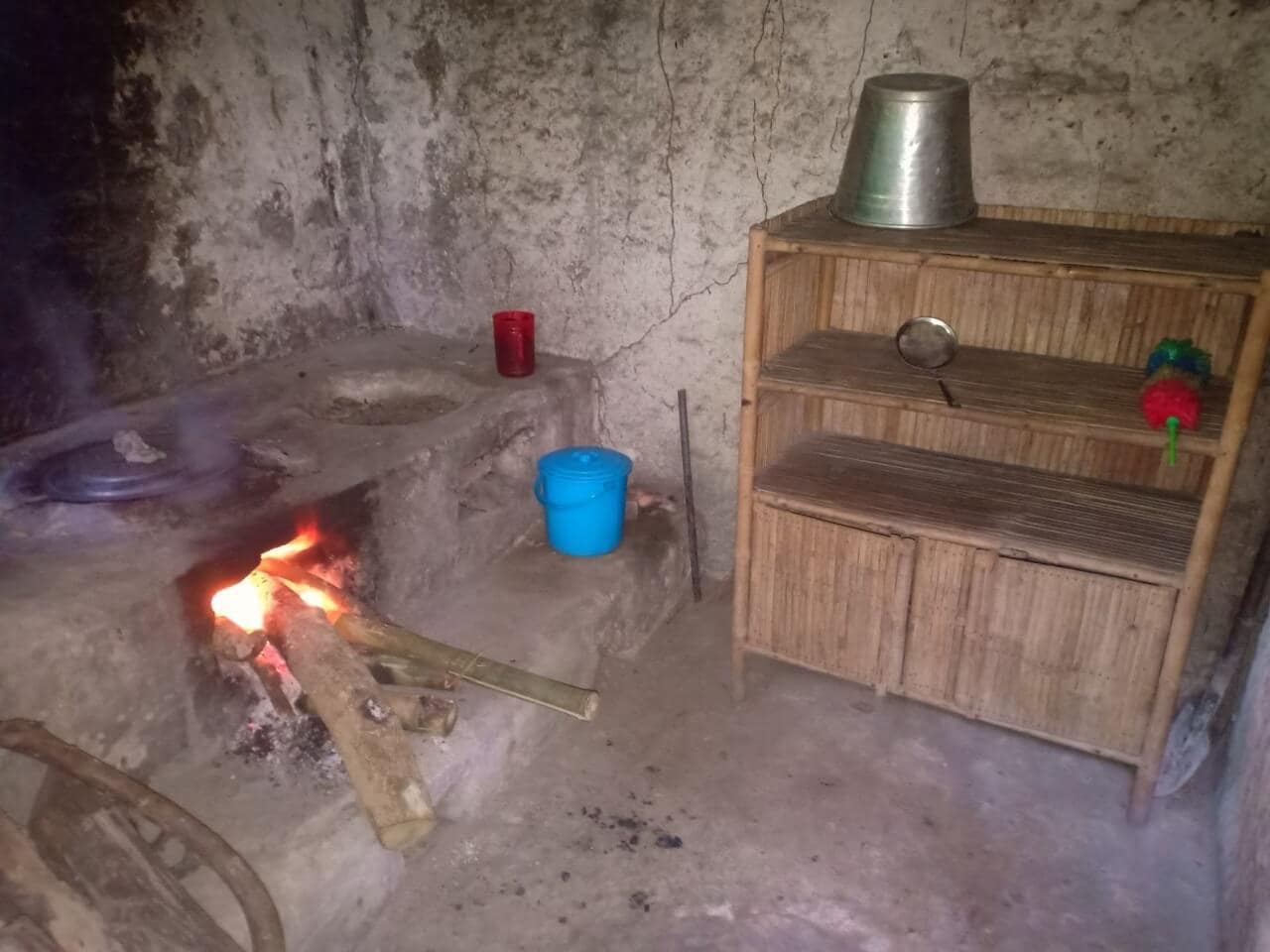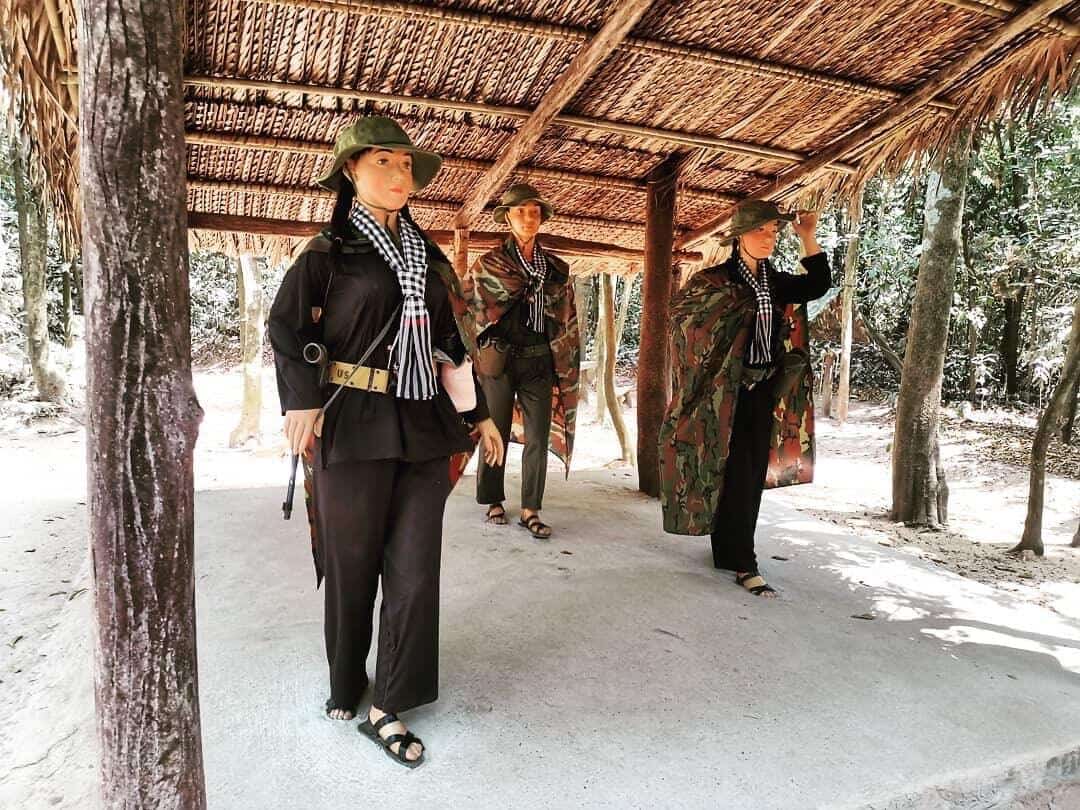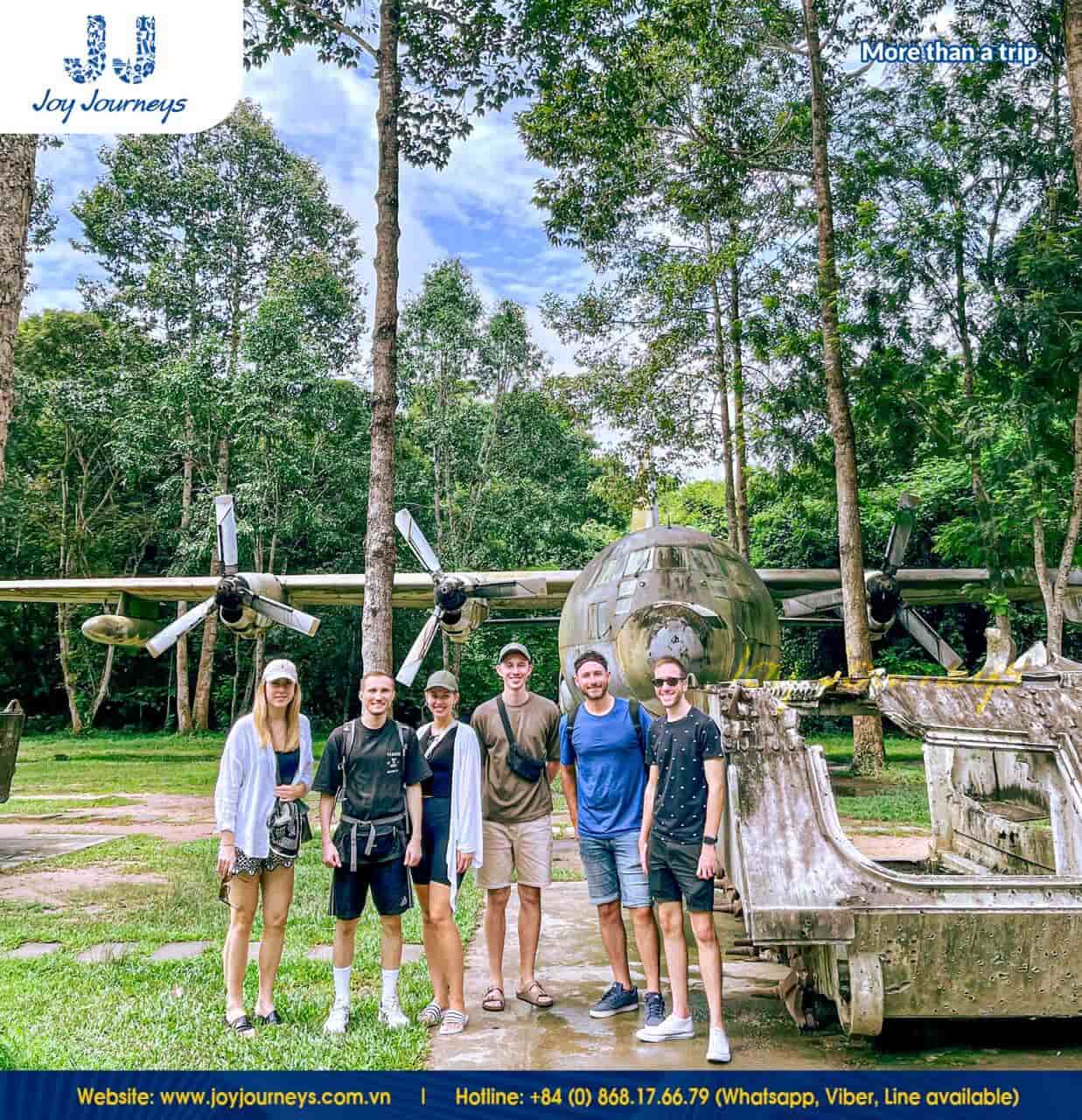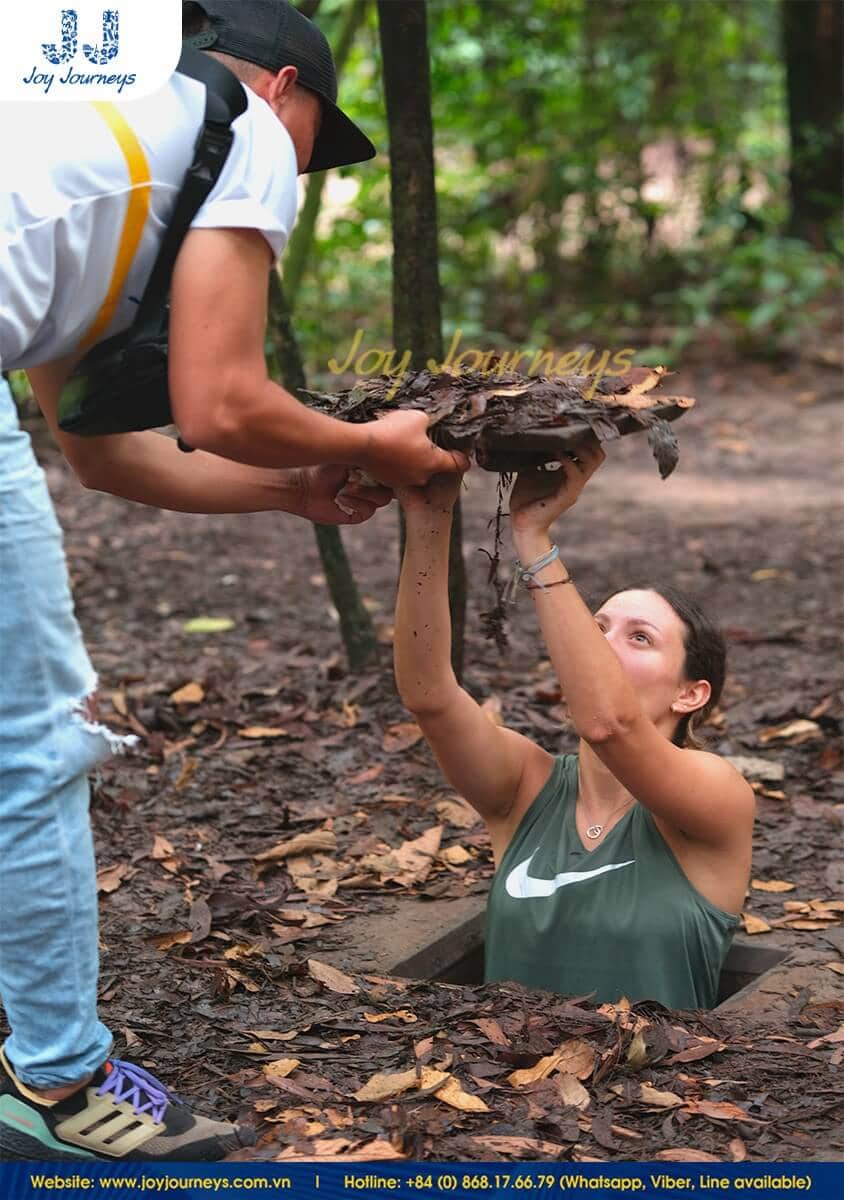The Cu Chi Tunnels are a must-visit destination for international tourists in Vietnam, offering a glimpse into the country’s remarkable history and the immense sacrifices of its soldiers. These underground passages served not only as a hub for revolutionary missions such as communication, ambushes, and strategy planning but also as a space for daily activities like washing and cooking.
Join Joy Journeys to uncover the daily lives of Viet Cong soldiers in Cu Chi Tunnels and witness how they adapted to life underground amidst extraordinary challenges.
Contents
A Day Lives of Viet Cong Soldiers in Cu Chi Tunnels
The daily lives of Viet Cong soldiers in Cu Chi Tunnels exemplified their remarkable resilience and unwavering determination to achieve independence for their country.
Waking Up in the Tunnels
Each day began with soldiers adjusting to the challenges of their underground environment. Duties and rest times were carefully divided to ensure safety and maintain readiness. Soldiers remained vigilant, ready to respond at a moment’s notice if the enemy breached the tunnels.
Duties and Responsibilities
The soldiers’ primary mission was to defend their country and secure peace, but life in the tunnels also required teamwork to handle daily tasks. These included cooking meals, digging and expanding the tunnel network, and providing medical care for the wounded, all performed under challenging conditions.
Meals and Rations
Food supplies were limited, so soldiers relied on staples like tapioca, a resilient crop that was easy to grow, cook, and store for several days. To supplement their rations, they ingeniously collected and sold bomb fragments in Saigon to buy additional food and supplies.

Rest and Relaxation
Despite the hardships, maintaining morale was vital. Soldiers took turns resting and engaging in recreational activities. Cultural performances, singing, and dancing brought moments of joy and camaraderie, helping to boost their spirits and strengthen their resolve.
Life in the Cu Chi Tunnels was a testament to the enduring spirit and ingenuity of the Viet Cong soldiers, who overcame unimaginable challenges to fight for their nation’s freedom.
Challenges and Adaptations
Health Hazards
Living in the tunnels posed numerous health risks due to the low light, high humidity, and poor ventilation. These conditions often led to skin infections and respiratory diseases, with malaria being particularly rampant. In fact, malaria became the second leading cause of death among those living and fighting in the tunnels.
Ingenious Solutions
Surviving underground required innovative solutions to meet basic needs like cooking and accessing clean water. The tunnels, which were 3 to 8 meters deep and just wide enough for a person to stoop, incorporated clever designs to support daily life.
For instance, underground wells at the forest edges provided water for drinking and household use. The Hoang Cam stove, a unique invention, minimized smoke emissions by quickly dispersing them, allowing soldiers to cook discreetly without revealing their location to the enemy.

Maintaining Morale
To sustain their fighting spirit, the tunnels housed various essential facilities, including hospitals, meeting rooms, rest areas, and kitchens. There was even a place for entertainment activities, offering solace amidst the hardships. These amenities helped maintain a sense of normalcy and strengthened the soldiers’ resolve.
Additionally, male and female soldiers’ unyielding determination and strong will to achieve independence and unify the country served as a source of inspiration and resilience in the face of unimaginable challenges.
The Role of Women and Children
The Cu Chi Tunnels, originally designed as shelters for villages, became home to local women and children who sought refuge from the dangers above ground.
Women’s Contributions
Women in the tunnels served as both a steadfast support system and courageous participants in the fight for independence. From early morning, they engaged in a variety of tasks, including cooking, cleaning, sewing uniforms, caring for wounded soldiers, and raising children.
When duty called, these women fearlessly volunteered for battlefield roles, such as acting as liaisons, scouting enemy movements, and even engaging in combat. Their contributions were profound; according to statistics, out of approximately 45,000 soldiers who lost their lives in the Cu Chi Tunnels, 9,000 to 11,000 were women.

Children’s Experiences
Children born and raised in the tunnels faced challenging conditions, including a lack of light and fresh air, high humidity, and the constant presence of insects. Despite these hardships, the women in the tunnels ensured the safety and education of the children by taking turns caring for them and providing a semblance of normalcy in their underground lives.
This remarkable resilience and unwavering determination of women and children highlight their critical role in the struggle for freedom and survival.
The Cu Chi Tunnels Today: A Living Museum
Preserving History
After the war, the Cu Chi Tunnels were transformed into a significant historical site, symbolizing the resilience and ingenuity of the Vietnamese people. Today, they are preserved in two key locations: Ben Duoc Tunnels and Ben Dinh Tunnels.
These sites serve as a testament to the nation’s strength and determination to protect its homeland. Thousands of visitors come daily to explore the tunnels and learn about the incredible stories embedded within their walls.

Visiting the Tunnels
The Cu Chi Tunnels, located in Cu Chi District, Ho Chi Minh City, are open to visitors every day from 7:00 AM to 5:00 PM. The Ben Dinh Tunnels, about 70 km from the city center, and the Ben Duoc Tunnels, approximately 85 km away, offer a variety of immersive experiences.
Visitors can watch historical documentaries, crawl through sections of the tunnels, explore booby traps, and even try out the shooting range.
A visit to the Cu Chi Tunnels provides a unique opportunity to step back in time and witness the ingenuity and perseverance of those who once lived and fought underground.
Why Choose a Guided Tour
A guided tour enriches your experience by providing valuable historical context and insights that bring the daily lives of Viet Cong soldiers in Cu Chi Tunnels to life. A knowledgeable guide can help you understand the struggles, ingenuity, and sacrifices that took place in these tunnels, transforming the visit from a simple tour into a deeply moving journey.

With their expertise, you’ll gain a deeper connection to the past, experiencing the tunnels not just as a tourist site, but as a living testament to courage and resilience.
Joy Journeys’ Cu Chi Tunnels Tours
At Joy Journeys, we pride ourselves on offering more than just a tour; we offer an authentic and immersive experience. Our expert guides, passionate about sharing the history of the Cu Chi Tunnels, ensure that every visit is meaningful.
With small group sizes, we provide a more personal and comfortable experience, allowing you to explore the tunnels at your own pace. Join us for a journey that goes beyond the surface, connecting you with the heart of Vietnam’s rich history.
Frequently Asked Questions
What were the life in the tunnels in Vietnam?
Life in the Cu Chi Tunnels was a constant battle against harsh conditions. Cramped spaces, poor lighting, and limited ventilation made daily activities like cooking, sleeping, and caring for the wounded incredibly challenging. Despite these hardships, the Viet Cong soldiers displayed remarkable determination and ingenuity in adapting to their environment.
What advantage did the Cu Chi Tunnels give the Viet Cong?
The tunnels provided the Viet Cong with a strategic edge in guerrilla warfare. This extensive underground network served as a base for manufacturing, resupplying, and planning operations, all within close proximity to their targets. The intricate design, as highlighted on the Cu Chi Tunnels map, made it nearly impossible for enemies to navigate or infiltrate the tunnels effectively, giving the Viet Cong a crucial advantage.
How much does it cost to visit Cu Chi Tunnels?
Ticket prices for the Cu Chi Tunnels are 35,000 VND for Vietnamese citizens and 125,000 VND for foreigners. For tourists traveling from Ho Chi Minh City, additional transportation costs can bring the total price to 750,000–1,000,000 VND per person, depending on the type of tour selected.
Who were the most feared soldiers in Vietnam?
During the Vietnam War, the People’s Army of Vietnam (PAVN) and its elite units, such as the Vietnamese Special Forces and the 1st Division, were highly respected and feared. The Viet Cong guerrillas, with their unconventional tactics, ambush strategies, and use of booby traps, also instilled fear in their opponents and played a critical role in the war’s outcome.
Conclusion
The daily lives of Viet Cong soldiers in Cu Chi Tunnels reveal an inspiring story of resilience and sacrifice during the Vietnam War. These brave individuals endured harsh conditions underground, demonstrating unwavering determination to protect their homeland. Exploring the tunnels offers a unique chance to appreciate their sacrifices and learn about their extraordinary ingenuity.
Discover their stories with Joy Journeys’ Cu Chi Tunnels tours. Visit https://joyjourneys.com.vn/ to plan your journey into history.


Related Posts
Saigon’s “Flower Market Replica”: Where To Find Them
Ho Chi Minh City’s floral charm is not limited to its bustling wholesale markets. Imagine wandering through a place where vibrant petals, fragrant blooms, and the spirit of traditional Vietnamese markets come alive—without the overwhelming crowds. A flower market replica captures that magic, blending the beauty of fresh flowers with the charm of a curated, […]
Is it Safe to Travel to Vietnam Right Now? A Complete 2025 Guide
Vietnam has emerged as one of Southeast Asia’s most captivating destinations, drawing millions of visitors annually with its rich culture, stunning landscapes, and incredible cuisine. However, many travelers still ask: Is it safe to travel to Vietnam right now? This comprehensive guide provides you with everything you need to know about Vietnam travel safety in […]
Ho Chi Minh Cu Chi Tunnels Tour: The Ultimate Guide
The Cu Chi Tunnels stand as one of Vietnam’s most remarkable historical sites, offering visitors a profound glimpse into the ingenuity and resilience displayed during the Vietnam War. For travelers, a Ho Chi Minh Cu Chi tunnels tour represents an essential experience that combines education, adventure, and deep cultural understanding. This comprehensive guide will help […]